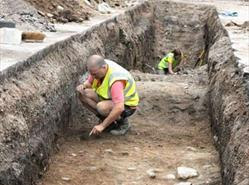Wednesday, September 19, 2012
Skeleton found beneath English parking lot may belong to King Richard III
King Richard III's burial grounds may no longer be a royal secret.
Researchers at the University of Leicester say they may have located the English monarch's remains beneath a parking lot in England — though it will be weeks before they can say for sure.
"Clearly we are all very excited by these latest discoveries," Richard Taylor, director of corporate affairs at the University of Leicester, told reporters Wednesday.
"Our focus is shifting from the archaeological excavation to laboratory analysis. This skeleton certainly has characteristics that warrant extensive further detailed examination."
The fully intact skeleton was found within the choir area at the site of the ancient Grey Friars church, which was demolished in 1538 at the order of Henry VIII during the Dissolution of Monasteries.
King Richard, the last English monarch to die in battle, is believed to have been buried at the church after he was killed during the Battle of Bosworth Field in August 1485.
The adult male skeleton showed signs of trauma to its head and had a barbed arrow head lodged between the vertebrae of the skeleton's upper back — injuries consistent with those sustained in battle.
"A bladed implement appears to have cleaved part of the rear of the skull," researchers said in a statement.
The skeleton also had spinal abnormalities, suggesting that the person suffered from severe scoliosis.
This abnormality would have made the person's right shoulder seem visibly higher than his left — a physical description that matches contemporary accounts of King Richard.
Peter Soulsby, Leicester's City Mayor, said that if the remains do belong to the late monarch, the findings will have "enormous implications" for the city.
"The discovery of King Richard's final resting place — if this is what we have — will enhance the telling of that story in a way we could never have planned," Soulsby said.
This is not the team's first discovery related to King Richard.
The archeologists announced last week that they had come across medieval paving stones that may have adorned a garden built in honor of the king by a 17th-century mayor of Leicester, Robert Herrick.
In 1612, Christopher Wren, father of the famous architect, visited Herrick and described seeing a three-foot pillar, bearing the inscription, "Here lies the body of Richard III sometime King of England," in the garden.
The possible remains of King Richard will now undergo DNA tests. But it will be as much as 12 weeks before researchers can confirm that they belong to the English monarch.
Subscribe to:
Post Comments (Atom)


No comments:
Post a Comment